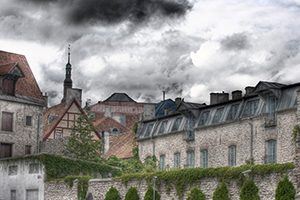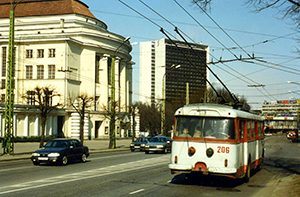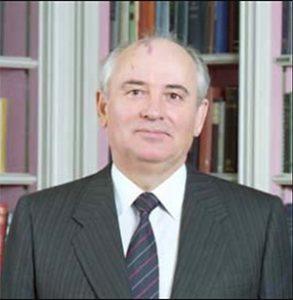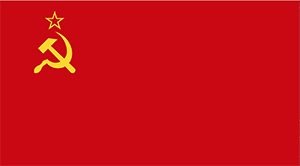by Bill Murray
 In the middle of the night of March 24, 1992, a pressure seal failed in the number three unit of the Leningradskaya Nuclear Power Plant at Sosnoviy Bor, Russia, releasing radioactive gases. With a friend, I had train tickets from Tallinn, in newly independent Estonia, to St. Petersburg the next day. That would take us within twenty kilometers of the plant. The legacy of Soviet management at Chernobyl a few years before set up a fraught decision whether or not to take the train.
In the middle of the night of March 24, 1992, a pressure seal failed in the number three unit of the Leningradskaya Nuclear Power Plant at Sosnoviy Bor, Russia, releasing radioactive gases. With a friend, I had train tickets from Tallinn, in newly independent Estonia, to St. Petersburg the next day. That would take us within twenty kilometers of the plant. The legacy of Soviet management at Chernobyl a few years before set up a fraught decision whether or not to take the train.
Monitoring stations in Finland detected higher than normal readings. The level of iodine-131 at Lovisa, Finland, just across the gulf, was 1,000 times higher than before the accident, according to the German Institute for Applied Ecology.
Russian authorities reported the accident in the media, and I think they felt self-satisfied for doing it, but Russian credibility had burned down with Chernobyl’s reactor 4. Any more, people thought the Soviets, as Seymour Hersh said about Henry Kissinger, lied like other people breathe. And as usual, solid information was hard to come by.
A news agency in St. Petersburg reported increased radiation, and the Swedish news reported panic in St. Petersburg. A lady in Tallinn that day told me her mother had called from St. Petersburg and they were closing the schools and sending children home to stay indoors. The Finnish Prime Minister fussed that seven hours passed before the Russians told him. It was frightening.
No one believed the plant spokesman when he said on TV, hey (big Soviet smile), no problem. No one trusted the Russians.
•••••
In the same way that provincial Balkan towns had never thought of themselves as national capitals (like Podgorica, which became the capital of Montenegro, and Ljubljana, the completely delightful capital of Slovenia), Tallinn was, had been since Soviet occupation in 1940, an outpost, a modest administrative hub, though far more architecturally charming than Soviet in its medieval center, with round stone guard towers and ancient walls all around.
Back then, in 1992, there just wasn’t that much of it. Tallinn was far smaller than its close neighbor Helsinki, itself only half a million. As usual when Soviet Communism got hold of a place, the difference between Soviet Tallinn and free Helsinki was night and day – in that order – even though they are unidentical twins, only 50 miles apart across the Baltic.
 The Finnish-built Viru hotel where I stayed (“Viro” is “Estonia” in Finnish) is the tall building in the background of this photo. It was just about the only place foreigners stayed, and something of a mild Estonian legend. The Viru opened in 1972 and adventurous Finns (whose language is similar enough to Estonian that they can understand one another) crept over to have a look at the Soviet way of life.
The Finnish-built Viru hotel where I stayed (“Viro” is “Estonia” in Finnish) is the tall building in the background of this photo. It was just about the only place foreigners stayed, and something of a mild Estonian legend. The Viru opened in 1972 and adventurous Finns (whose language is similar enough to Estonian that they can understand one another) crept over to have a look at the Soviet way of life.
Naturally, for the Viru’s first twenty years the KGB spied on guests. The elevator showed there were 22 floors. The 23rd floor housed the KGB radio center, used to listen in on guests and high enough to communicate with Helsinki’s KGB station across the Gulf of Finland. Today a museum on the 23rd floor displays the listening equipment.
With Finnish Markkas around hard currency prostitution flourished. Girls came from across the Soviet Union and learned passable Finnish. A flight of stairs behind sofas in the lobby allowed prostitutes to surreptitiously show customers the soles of their shoes – on which they had written their price.
Tallinn was a rarity in the USSR, the only place you could watch western TV, as broadcast from Helsinki. Taru Mäkelä, director of a film about the Viru Hotel, said “Moscow boycotted the Los Angeles Olympics in 1984. The games were not televised in the Soviet Union. Then the whole of the Moscow elite travelled to the Viru hotel to watch the Olympics on Finnish television.”
•••••
Finnish TV stayed on the radiation leak all day and we were glad they did. A consensus emerged on the other side of the gulf that this was no Chernobyl. The Finns had boats out on the gulf measuring the air, and at Kotka up on the Finnish/Russian border they didn’t measure anything at all.
The Commission on Security and Cooperation in Europe had a politicians’ meeting in Helsinki that day. They showed it on Finnish TV and we decided that if that room emptied we probably ought to leave, too. The morning of the train, the Voice of America radio news had the leak as about its fifth story and we believed the Americans when they told us it was okay. We took the train.
A compartment of four – two Russians, a rotund but diminutive middle-aged woman unwilling to engage, a stern woman in a tight dress, my friend Steve and me. We Americans brought liters of water, a six-pack of strong Finnish beer called Koff, Elephant beer from Denmark and beef jerky.
Once the onion domes of the Orthodox church (Strong, confident, well-kept, the nicest place in town) fell away outside the compartment, the countryside slumped into a general downtrodden despondence.
Ask the woman with the abacus in the рестора́н, the dining car, where you can smoke on this train. She indicates a place between cars. It smells like smoke and out in the open air you discover makeshift ashtrays, tin cans with a picture of a pig on them opened three quarters of the way, the top peeled back and bent around a rail on the window. State of the art. And the only thing on the wall is a poster-sized calendar for two years before. That about sums it up.
Grim, gray, scant daylight. Snow weighed on the land, pressing it down, muffling sounds and dampening prospects, hoisting no enthusiasm for this halting new freedom, whatever it may mean. A nation born from Soviet cynicism expected no warmth, no easy living, only hard times. Official statistics put the “solved crime rate” down to 14%.
Nobody had any money and nobody had any jobs except those that paid in rubles. Which were not money. Estonians knew better than anybody that “Russian money is not good money,” and you were hard pressed to find anyone who would take it for anything. Finnish markkas, dollars and Deutschmarks, that was all. They would get a new currency the next month, the Kroon, also worthless, before a long climb out to the Euro.
•••••
With the Sosnoviy Bor accident, history seemed to repeat, the memory of Chernobyl still burned in. From his retirement sinecure fourteen years later, Mikhail Gorbachev used the 20th anniversary of the accident in April 2006 to finger Chernobyl as a turning point in the collapse of the Soviet Union.
“The Chernobyl disaster,” he wrote, “opened the possibility of much greater freedom of expression, to the point that the system as we knew it could no longer continue.” He wrote that he “started to think about time in terms of pre-Chernobyl and post-Chernobyl.” He protested his administration’s innocence, insisting “nobody knew the truth.”
“Of course, the world first learned of the Chernobyl disaster from Swedish scientists, creating the impression that we were hiding something. But in truth we had nothing to hide, as we simply had no information for a day and a half.” That is not true, for within sixteen-odd hours of the Chernobyl explosion, Moscow’s radiation hospital had 129 patients already under treatment, airlifted from the blast site.
 It may serve the former General Secretary to see the collapse of the USSR on his watch as cataclysm, an event beyond the control of a mortal leader, but Gorbachev didn’t bestow the “much greater freedom of expression” he wrote that Chernobyl set in train. It rode in on the shock tide of the government’s opacity with vital health information. Soviet citizens offered up an appalled general disgust and prised the lid of Soviet secrecy from Gorbachev’s hands.
It may serve the former General Secretary to see the collapse of the USSR on his watch as cataclysm, an event beyond the control of a mortal leader, but Gorbachev didn’t bestow the “much greater freedom of expression” he wrote that Chernobyl set in train. It rode in on the shock tide of the government’s opacity with vital health information. Soviet citizens offered up an appalled general disgust and prised the lid of Soviet secrecy from Gorbachev’s hands.
Radiation was mysterious, menacing, personal and permanent. Before, most people were good Soviet citizens in the same way you may be a good American or Malaysian or Chilean. Only dissidents were dissidents, there weren’t many of them and in Russia nobody knew much about them, or thought they were very important.
Chernobyl made things personal. Now we were talking about radiation in your little girl’s milk. They said the government mixed irradiated cow meat with uncontaminated beef and sold it across the land, to dilute all the contaminated meat.
Everybody believed it. Now your government was trying to poison you.
Hedrick Smith, a former New York Times Moscow bureau chief, wrote, “by the early 1980’s, the brightest people in the Soviet system could see the telling contrast between Soviet stagnation and western progress.” In a 1986 visit to Moscow I ate at a pizza restaurant with a dozen menu items but only one kind of pizza actually served.
Behind the monolith of Soviet government lurked only mortals, panicked and mendacious. The mask had slipped. Chernobyl punched holes through the Soviet ramparts and reality poured out.
Like Nixon with Watergate and Trump with his Moscow tower, Gorbachev preferred to change the subject. When Gorbachev took his road show to Havana in April 1988, Fidel Castro stroked his beard and declared, “Perestroika is another man’s wife. I don’t want to get involved.”
The General Secretary tried releasing political prisoners. Closing the gulag camp Perm-35, one of the harshest, got Mart Niklus, a zoologist and ‘dangerous recidivist’ from Tartu, Estonia, a bus ticket home. (‘Perm’ sounds like permafrost, like tundra, but it’s not so far from Moscow, on the non-Siberian side of the Ural mountains.) That summer hundreds of thousands of Estonians staged patriotic “song festivals.” Before the year was out the Estonian parliament effectively declared home rule.
The empire reeled, and at every extremity. In February 1989 Lt. General Boris Gromov’s fortieth army, untold columns of troops, tanks and armored personnel carriers, slunk back across the Friendship Bridge into the Soviet Socialist Republic of Uzbekistan, bringing to a close a nine year occupation of Afghanistan that cost 15,000 lives.
In 1989 the Soviet Union’s Eastern European satellites wobbled out of orbit and by autumn they fell from the Soviet sky. Gorbachev the traveling salesman visited Helsinki that fall. His spokesman Gannadi Gerasimov made weak light of the situation.
“You know the Frank Sinatra song, ‘I Did It My Way’?” he asked reporters. “Hungary and Poland are doing it their way.” (Funny the extent to which they still are.)
 Two weeks later the Berlin Wall was down and now the Soviet republics themselves were afray. Soviet APCs dispersed a demonstration killing 20 in Tbilisi. Azerbaijani villagers beat Armenians and Armenians ejected Azeris, igniting the Nagorno-Karabakh War that lasted six years and killed some 30,000. Lithuania declared independence and Soviet APCs seized the TV tower in Vilnius, killing 13. And by then it was all too late.
Two weeks later the Berlin Wall was down and now the Soviet republics themselves were afray. Soviet APCs dispersed a demonstration killing 20 in Tbilisi. Azerbaijani villagers beat Armenians and Armenians ejected Azeris, igniting the Nagorno-Karabakh War that lasted six years and killed some 30,000. Lithuania declared independence and Soviet APCs seized the TV tower in Vilnius, killing 13. And by then it was all too late.
Political prisoners were out of the gulag, the cat was out of the bag and over the two years to come the whole shabby Soviet edifice slow-motion crumbled.
•••••
Today Estonia is a European Union and NATO member. Last year it served as president of the EU Council. Stats show it top five in the EU in ease of doing business, number six in freedom of the press, just outside the top ten in perception of corruption, and dead last in public debt.
But Estonia’s physical location next to Russia is impossible to change, and pressure from its neighbor is unrelenting: Estonia’s removal of a Soviet war memorial in Tallinn brought about a three-week long cyber attack in 2007. In 2014 Russia arrested an Estonian security officer in a disputed area near the border (who was repatriated in a prisoner swap). Constant, low-level tension is a daily fact of life.
•••••
When the three Baltic leaders, Dalia Grybauskaitė of Lithuania, Kersti Kaljulaid of Estonia and Raimonds Vējonis of Latvia had their audience with President Trump on April 3rd of this year, Le Monde reported (here’s an English report) that the American president chastised the leaders “for starting wars in the 1990s that lead to the break-up of Yugoslavia.”
It’s not unusual that ordinary folks confuse the Baltics and the Balkans. Both are regions made up of small countries at the European periphery. But it has to be dispiriting to the Baltic leaders that the American president can’t be bothered to master this particular brief, especially since one of his most influential briefers – his wife – was born in Yugoslavia.
The Baltic countries are once again uneasy. The U.S. Ambassador to Estonia stood down in June, “telling friends that he cannot abide President Trump’s apparent hostility toward institutions that have stabilized Europe since the end of the Cold War.” Comfort, while avidly sought, is elusive in a western alliance thrown into turmoil by a transactional American president to whom the Baltics appear unlikely to yield a profit.
•••••
(Top photo from earthphotos.com. Others via Wikimedia Commons.)
Note: in my last 3QD column, On the Road: Wildebeest Crossing, I wrote that bees’ and ants’ “tiny brains don’t do complex decision-making, but individual bees and ants, genetically predisposed to carry out duties associated with a few jobs – ‘guards,’ ‘workers,’ ‘scouts’ – collaborate to create colonies. Termites form mounds the same way.” A subsequent article in Aeon titled Bee Brained surveys research that suggests insects may have a richer intellectual life than I portrayed.
